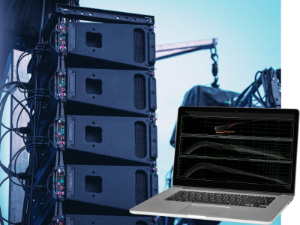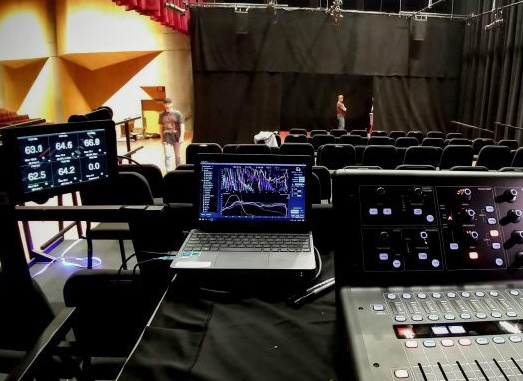Modern audio systems engineers have a plethora of tools at their disposal, ready to assist in all stages of system optimization. Once reserved for premium product lines, a variety of useful software is now available for many mid-market offerings and continues to trickle down further.
Though it’s an exciting trend that increases the capabilities of both products and technicians alike, it can be overwhelming to folks who are just beginning to learn their way around this new landscape. This array of tools is used to fulfill three major functions in system optimization: prediction, control, and measurement.
What follows is an explanation of each of these functions and how they relate to one another, and an overview of offerings from several manufacturers.
Enhanced Listing
Adamson Systems Engineering
adamsonsystems.com

Adamson’s new design and control software has added a proprietary optimization algorithm that gives users the ability to fine tune the performance of their line arrays.
In conjunction with onboard DSP in each powered CS loudspeaker cabinet, the optimization function enables accurate and uniform response across the performance area without adding any additional latency. The CS platform allows optimization to be resolved per box, giving even more granular control than is possible with rack powered solutions where only circuit-defined control is available.
Calculating response from multiple simulated listening points in the venue design, the user can adjust the on-axis response using a spline tool to the shape the desired coverage. Overall headroom can be managed from +/- 2 dB to +/- 9 dB in 1 dB increments to either retain maximum sonic performance or counter any potential loss in headroom.
Adamson’s optimization implementation also offers the ability to optimize a selected bandwidth of the full range system by applying upper and lower frequency restraints to the calculation. This can be particularly helpful in less-than-optimal acoustic environments where engineers need to manage tricky room nodes or unruly sources on stage. Find out more here.
Making A Forecast
Prediction is the first step in the successful implementation of a PA system, and could be considered the most important. What will the pattern of a loudspeaker’s coverage be? How will level and tone vary within that coverage area? These are just some questions addressed by prediction.
Given a single loudspeaker on a stand, most folks will intuitively predict that it should be placed in front of an audience and pointed towards them for best results. However, as the number of loudspeakers grows to tens or hundreds, the power and precision of acoustic prediction software becomes necessary.
Software prediction tools allow system engineers to develop accurate estimations of a PA system’s coverage in a given space. The user inputs the listening area dimensions, and the number, type, and location of each loudspeaker used in the design.
The most rudimentary programs operate in two dimensions, showing frequency response and maximum SPL on axis to one source at a time. When working with line arrays, the splay between elements can be manipulated, and most programs have “auto-splay” functionality, which can quickly generate a “starting point” for array aiming and splay.
The 2D “landing strip” modeling approach has limitations; most audience members will be seated outside of the simulated cross-section, and it often cannot predict interactions between multiple speakers in the horizontal plane. More full-featured prediction programs operate in three dimensions, allowing for more precise decisions to be made about the horizontal and vertical aiming of each speaker.
In addition, most prediction programs consider the phase responses of the loudspeakers and can estimate proper alignment delays between subsystems. By offering such a holistic consideration of the system behavior, prediction software allows a rapid, iterative approach to PA system design. Otherwise, “on the fly” iterative design would require repeatedly lowering, adjusting, and raising an array, which is impractical.
Manufacturers have taken two main approaches towards prediction software. Some choose to write and release their own proprietary software, while others instead release high-precision measurements of their loudspeakers in a standard format for use in third-party applications. Examples of the former include Adamson Systems Engineering software, Martin Audio DISPLAY 3, L-Acoustics Soundvision, Meyer Sound MAPP 3D, EAW Resolution 2, and JBL Line Array Calculator.
The predominant third-party prediction software is AMFG EASE Focus; manufacturers can allow their products to be predicted in EASE by releasing measurements in Generic Loudspeaker Library (GLL) format. This approach allows users to mix products from multiple manufacturers in their designs, which is an indispensable feature for users whose inventory or design incorporates a variety of different loudspeaker products.
Meanwhile, manufacturers who create bespoke prediction software can better integrate it with the rest of their product line. It can reflect the particulars of their rigging, integrate with other parts of their ecosystem, and help ensure that their products deliver more consistent performance in the field.
Advantages Of Control
The next major component of system optimization is control. As with prediction, the approach to system control has undergone major transformation in recent years. Decades ago, a graphic equalizer, high-pass filter, limiter, and passive crossover could be considered a sophisticated control solution for a sound system.
Now, basic control over a single loudspeaker is often implemented digitally, and may include mute, gain, polarity, equalization, crossover filtering, limiting, and delay. Many products offer multiple modes; for example, a powered loudspeaker might include presets for main PA use and for stage monitoring. For larger systems, this level of control can often be applied to individual loudspeakers, zones or subsystems, or the entire system at once.
Recent years have seen an industry-wide trend towards “closed” control ecosystems from each manufacturer, which guarantees a more consistent result. Amplifiers and powered loudspeakers often have manufacturer-developed presets, designed to ensure similar response across a product line.
With drivers and amplifiers both known quantities, limiting, driver protection, and even system diagnostics can be implemented with high accuracy. Yet another benefit is that some manufacturer’s prediction tools can push configurations directly to system control, saving significant time and reducing the likelihood of user error.
One part of system control that has remained beyond the grasp of most manufacturers is “production” DSP, often deployed between the front of house console and the main system control. Rather than learn the ins and outs of each manufacturer’s system control, many FOH engineers prefer to adjust system tonality as a whole, often using a Lab Gruppen Lake or Meyer Sound Galileo processor. This allows the mix engineer an avenue for tonal adjustment that is kept segregated from the more granular processing and routing work done by the systems engineer.
Filling In The Blanks
Even the most capable control platform is useless if decisions within it are made without justification. By measuring the response of a system deployed in a space, engineers collect data to inform those decisions and verify that design goals have been met.
Measurement often begins with verification of a system’s most basic attributes. Are signals routed properly to loudspeakers? Does each loudspeaker function? Do the left and right sides of the PA match? From there, measurement data informs decisions about gain, equalization, polarity, and timing for each loudspeaker or subsystem in a design.
Before the advent of personal computers, sound system measurement usually required a source signal with a known spectrum — for example, pink noise, which was then viewed on a fractional octave banded RTA (Real Time Analyzer). Being a source-dependent measurement, this has two key disadvantages; it displays the spectrum of the signal rather than the response of the system itself, and it’s blind to time information.
Today, dual-channel fast Fourier transform (FFT) measurement systems are the most prominent solution to those problems. Dual-channel FFT measures the transfer function of a loudspeaker or subsystem. The transfer function has two parts, the magnitude response and the phase response, as well as producing time-domain impulse response data.
Comparing magnitude response between locations will show the difference in level and tonality between them. Comparing the phase response and impulse response data between adjacent loudspeakers allows the system engineer to time-align them to one another.
The most widespread audio measurement platform is Rational Acoustics Smaart, though Meyer Sound’s SIM 3 and AMFG SysTune are also used to do this work. In rare cases, a manufacturer will develop their own dual-channel FFT, usually hoping to allow deep integration with their control suite. A prime example is the L-Acoustics M1 measurement platform.
A more common approach is to use the Smaart Application Programming Interface (API) to pass measurement data directly from the analyzer into the system control environment. This is the route taken by JBL Network Manager, Powersoft Armonia, Outline Newton, Lab Gruppen Lake, Waves TRACT, and others.















